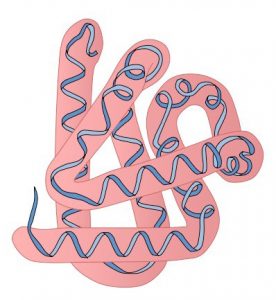How Are Proteins Categorized?
Proteins are categorized into groups called “protein families” based on shared evolutionary origins and similar characteristics.
Families: Superfamilies
Proteins in superfamilies are more distantly related to one another.
Example: myoglobin and hemoglobin to neuroglobin
Proteins classified by their shape are either globular or fibrous.
Globular Proteins
Globular proteins (aka spheroproteins) are spherically shaped.

Examples: hemoglobin, immunoglobulins
Soluble in: water, acids, bases
Fibrous proteins
Fibrous proteins (aka scleroproteins) are elongated and strandlike, like wires.

Examples: keratin, collagen, elastin
Soluble in: strong acids and alkalis
Insoluble in: water, weak acids, weak bases
Proteins classified by composition are either simple or conjugated.
Simple Proteins
Simple proteins contain only amino acids.
Conjugated Proteins
Simple proteins contain only amino acids.
Conjugated proteins contain both a protein and a non-protein component.